Close your eyes and think about architecture, try to establish a pattern of what is something astonishingly beautiful for you and for people in general and I am sure that when you open them again you will hardly come even closer to what Antoni Gaudi should have had in his mind when he created these beautiful pillars and that odd ceiling for his Sagrada Familia Cathedral. Who would have thought of such daring strange shapes then, by the end of the XIX century and who can think of them right now unless you take a computer and use an advanced software to calculate mathematical possibilities for architectural impossibles.
Barcelona photos: Daily photographs of Barcelona, Spain. Pictures of a modern city with travel tips in a personal photoblog. A photography and travel site. Art, architecture, people and traditions. Travel to Barcelona through my camera, know more about our city and towns nearby. Welcome!
Wanna be featured?
Showing posts with label art nouveau. Show all posts
Showing posts with label art nouveau. Show all posts
December 11, 2015
Crypt Pillars and Ceiling at Sagrada Familia Cathedral
Labels:
architecture,
art nouveau,
gaudi,
modernism,
modernisme,
pillars,
sagrada familia
Location: Barcelona, Spain
Carrer de Mallorca, 401, 08013 Barcelona, Spain
December 19, 2013
Palau Baro de Quadras - Ramon Llull Institute's Brand New Headquarters

Built between 1904 and 1906, Palau Baro de Quadras, is a beautiful sample of Catalan modernisme. This palace was designed by architect Josep Puig i Cadafalch for Baro de Quadras (baron of Quadras). The building's main entrance is at Avinguda Diagonal 373, where you can appreciate a very elaborate façade of European Gothic influence blended with Neo-Plateresque style.
From across the street you seem to be standing before a Renaissance Italian palazzo rich in lattice work. Worth mentioning are the gargoyles and floral adornments on this side of the palace. On carrer Roselló there is a backdoor entrance. That side, features a Modernista style with some hints of the Wiener Sezession school (Vienna Art Nouveau or Jugendstil).
This emblematic place was known till last October as Casa Asia, which is a public cultural institution devoted to the promotion of projects to strengthen relationships with that continent and that is going to inaugurate its new premises inside Hospital de Sant Pau's modernist complex. For those who don't know, the old Art Nouveau buildings there have been restored and will be used for other services.
Palau Baro de Quadras has been donated by the City Town Hall to Ramon Llull Institute. As part of their mutual collaboration, the City Council will integrate in the institute's consortium with the intention of participating in the international promotion of Barcelona and Catalonia.
Institut Ramon Llull is a public body created to foster Catalan language studies at international universities and to promote Catalan cultural production in all artistic areas.
But let's return to our palace. Notice in the image above, the stairway to the upper floor. Upon entering through either the main gate or the backdoor, you arrive to this place which has a small fountain to the right over a beautiful mosaic floor. Besides the profuse adornments surrounding the stairs, you really ought to see the stained glass ceiling that is slightly shown in the upper part of the photo. Some other day I will show you the gallery in the second floor and other details of this wonderful building so well preserved.
I hope you enjoyed yet another Barcelona photo here at Barcelona Photoblog. Perhaps you want to check this previous post about Palau Baro de Quadras.
But to know a place you need to see it for yourself and not just an image. Take a look at this very short video with slides that show the whole palace.
From across the street you seem to be standing before a Renaissance Italian palazzo rich in lattice work. Worth mentioning are the gargoyles and floral adornments on this side of the palace. On carrer Roselló there is a backdoor entrance. That side, features a Modernista style with some hints of the Wiener Sezession school (Vienna Art Nouveau or Jugendstil).
This emblematic place was known till last October as Casa Asia, which is a public cultural institution devoted to the promotion of projects to strengthen relationships with that continent and that is going to inaugurate its new premises inside Hospital de Sant Pau's modernist complex. For those who don't know, the old Art Nouveau buildings there have been restored and will be used for other services.
Palau Baro de Quadras has been donated by the City Town Hall to Ramon Llull Institute. As part of their mutual collaboration, the City Council will integrate in the institute's consortium with the intention of participating in the international promotion of Barcelona and Catalonia.
Institut Ramon Llull is a public body created to foster Catalan language studies at international universities and to promote Catalan cultural production in all artistic areas.
But let's return to our palace. Notice in the image above, the stairway to the upper floor. Upon entering through either the main gate or the backdoor, you arrive to this place which has a small fountain to the right over a beautiful mosaic floor. Besides the profuse adornments surrounding the stairs, you really ought to see the stained glass ceiling that is slightly shown in the upper part of the photo. Some other day I will show you the gallery in the second floor and other details of this wonderful building so well preserved.
I hope you enjoyed yet another Barcelona photo here at Barcelona Photoblog. Perhaps you want to check this previous post about Palau Baro de Quadras.
But to know a place you need to see it for yourself and not just an image. Take a look at this very short video with slides that show the whole palace.
Labels:
architecture,
art nouveau,
casa modernista,
modernisme
Location: Barcelona, Spain
Avinguda Diagonal, 373, 08008 Barcelona, Spain
December 03, 2013
Casa Comalat Backside at Carrer Corsega 316, Barcelona
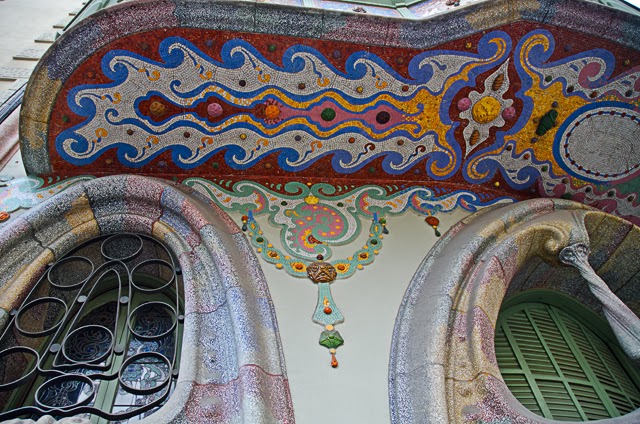
Casa Comalat is one of those secret places of Barcelona everyone would like to discover but sadly it is closed to the public. This Modernista house has two completely different sides which have been featured in Barcelona Photoblog in the past. There is the front side, magnificent, full of adornments, but sober in comparison with the backside façade, at carrer Corsega 316, which I find much more interesting and attractive.
But before we start, you should know some facts: The building is named after the its proprietor, Sr. Comalat, a moneylender that commissioned it to architect Salvador Valeri i Pupurull (1873-1954). Salvador Valeri built a house that is slightly different to other Modernista houses of the times, very rich in ornaments, very decorative, it became a perfect sample of Late Modernisme. Maybe you need a video to fully comprehend what Late Modernisme looked like and to discover what only a local Barcelona TV has unveiled, the inner secrets of Casa Comalat. The video is not in English but you really ought to watch it.
With regards to the Barcelona photo of the day, Casa Comalat Backside, you can appreciate the elaborate ceramics on balconies and windows by artist Lluís Bru i Salelles and the over-undulating shapes framing wood blinds for the first time in Modernisme. Rigalt i Granell, a renown company at that time, was in charge of the stained glass works. Certainly, never backsides were so much better than front doors.
Previous posts:
Art Nouveau Balconies
Art Nouveau Balconies
Labels:
architecture,
art,
art nouveau,
casa comalat,
catalan art nouveau,
modernisme
Location: Barcelona, Spain
Carrer Còrsega, 316, 08037 Barcelona, Spain
October 23, 2013
Casa Comalat: Art Nouveau Balconies
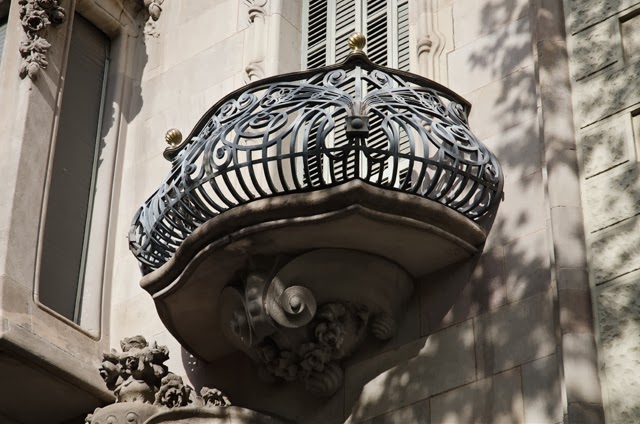
Casa Comalat is the most emblematic modernist house by Catalan architect, Salvador Valeri. This jewel of Catalan Art Nouveau, has two façades, the main entrance facing Av. Diagonal and the rear at carrer Roselló.
At first sight, nobody could tell the two of them belong to the same building if it were not for the intense use of undulated shapes and exuberant decoration, prominent features in the work of this artist.
Built between 1909 and 1911, the house inevitably reminds you of the strong influence of Gaudi's famous curves upon the artists of his times.
In the image today, there is only a balcony, as both sides of the house have been covered here in Barcelona Photoblog in the past (Avinguda Diagonal - Casa Comalat and Catalan modernisme: Casa Comalat).
Of course, this is not any kind of balcony as you can appreciate in the extremely beautiful and whimsical shapes of this wrought ironwork. I could tell you about the fabulous doorway, the gallery defiantly protruding from the façade crowned by an impressive pinnacle or about the shape of the turret on top of the building, or what is more, we could be talking for hours about the wooden galleries and the delightful ceramics on the other side of Casa Comalat, that are not precisely what you would choose to adorn the back side of anything, in the sense that, on that part, you feel like you are about to enter the Candy house in Hansel and Gretel fairy tale but why not concentrating on the details of this single balcony and let imagination fly. I took more pictures that will eventually appear on this blog, so do not miss them. Thanks for your time.
At first sight, nobody could tell the two of them belong to the same building if it were not for the intense use of undulated shapes and exuberant decoration, prominent features in the work of this artist.
Built between 1909 and 1911, the house inevitably reminds you of the strong influence of Gaudi's famous curves upon the artists of his times.
In the image today, there is only a balcony, as both sides of the house have been covered here in Barcelona Photoblog in the past (Avinguda Diagonal - Casa Comalat and Catalan modernisme: Casa Comalat).
Of course, this is not any kind of balcony as you can appreciate in the extremely beautiful and whimsical shapes of this wrought ironwork. I could tell you about the fabulous doorway, the gallery defiantly protruding from the façade crowned by an impressive pinnacle or about the shape of the turret on top of the building, or what is more, we could be talking for hours about the wooden galleries and the delightful ceramics on the other side of Casa Comalat, that are not precisely what you would choose to adorn the back side of anything, in the sense that, on that part, you feel like you are about to enter the Candy house in Hansel and Gretel fairy tale but why not concentrating on the details of this single balcony and let imagination fly. I took more pictures that will eventually appear on this blog, so do not miss them. Thanks for your time.
March 09, 2011
Casa Mila by Gaudi: Modernist Staircase Detail
Art has many ways, just as mother nature never stops surprising us with her capricious designs. The creativity of man knows no boundaries and a good example of that is the work of Catalan genius, Antoni Gaudi. In this image, the staircase at Casa Mila also known as La Pedrera is just a staircase, a beautiful one in fact, but the handrail, oh, the wrought iron handrail is so profuse in impossible adornments, so elaborate, that it is difficult not to surrender to this architect's divine talent. Not that complex motifs were invented by him, since we have Baroque for that, but the new approach, the use of natural elements like leaves, conceived with such uncanny mathematical precision, sometimes quite hard to translate from his mind into the final piece, makes these architectural jewels unique.
January 30, 2011
Modernist Building, Rambla Catalunya 61 next to Arago St.

Newly restored modernist building on the corner of Rambla Catalunya and Carrer Arago.
Located exactly at Rambla Catalunya 61 this apartment building with offices to rent (I have seen one with 150 square meters advertised for 2500 EUR/month!) immediately grabs our attention for that interesting combination of undulated balconies, exuberant ironwork and glass covered galleries.
I think you should examine this Eixample quarter Art Nouveau gem closer in Google street view: Modernist House Rambla Catalunya 61.
Located exactly at Rambla Catalunya 61 this apartment building with offices to rent (I have seen one with 150 square meters advertised for 2500 EUR/month!) immediately grabs our attention for that interesting combination of undulated balconies, exuberant ironwork and glass covered galleries.
I think you should examine this Eixample quarter Art Nouveau gem closer in Google street view: Modernist House Rambla Catalunya 61.
January 20, 2011
Casa Batlló: Masked Balconies

To stay in Barcelona without visiting Casa Batlló is like being in Paris and forgetting about the Eiffel tower, with all due respect to Sagrada Familia and Sacre Coeur respectively.
The famous house designed by Gaudi is so, let's say, 'different' that tiptoeing her is almost a sacrilege.
Besides the exquisite trencadis (shattered tiles) on the façade, the balconies are like carnival masks, concealed faces watching upon passersby.
The whole building has more to do with patterns we usually find in nature than with man's rationale, like the peculiar contours of the roof that simulate some sort of scaly skin as that of a lizard or a snake, or why not, a dragon, or the impossible arches and oval windows in the lower floors deprived of everything that recalls a straight line.
I tried to apply some symmetry at the moment of framing the picture but it was certainly pretty hard.
Here is a previous post about Casa Batllo.
The famous house designed by Gaudi is so, let's say, 'different' that tiptoeing her is almost a sacrilege.
Besides the exquisite trencadis (shattered tiles) on the façade, the balconies are like carnival masks, concealed faces watching upon passersby.
The whole building has more to do with patterns we usually find in nature than with man's rationale, like the peculiar contours of the roof that simulate some sort of scaly skin as that of a lizard or a snake, or why not, a dragon, or the impossible arches and oval windows in the lower floors deprived of everything that recalls a straight line.
I tried to apply some symmetry at the moment of framing the picture but it was certainly pretty hard.
Here is a previous post about Casa Batllo.
Labels:
architecture,
art nouveau,
casa batllo,
gaudi,
modernisme
Location: Barcelona, Spain
Passeig de Gràcia, 43, 08007 Barcelona, Spain
January 17, 2011
Modernist Lamp, Casa Amatller, Barcelona
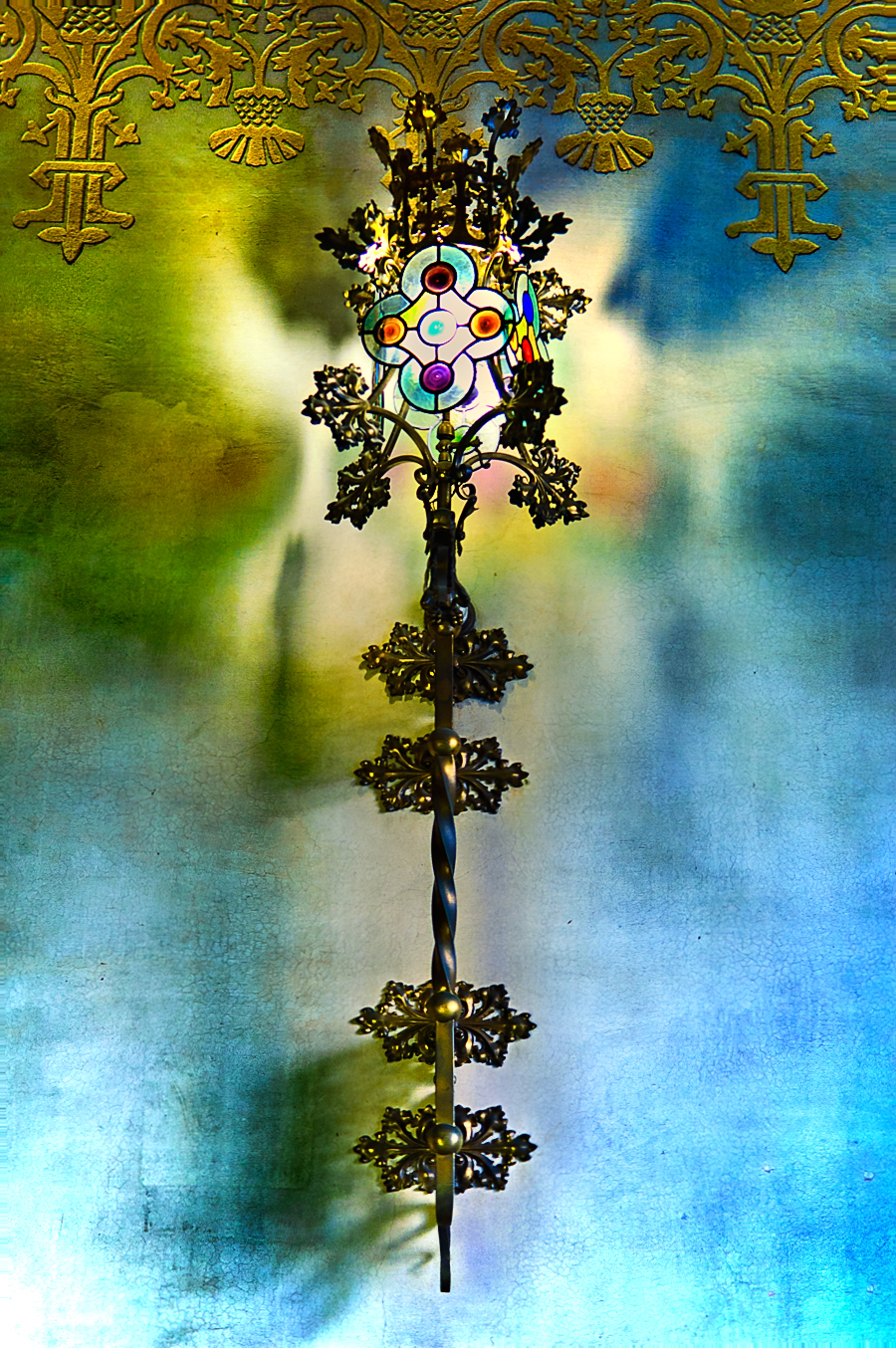
This is a detail of one of the art nouveau style lamps at Casa Amatller on Passeig de Gracia, Barcelona. Of course the original is more beautiful but I hope this is enough teaser for you to visit the famous house and take a good look at it.
More about Casa Amatller in this previous post: Casa Amatller Modernist Stained Glass Ceiling
More about Casa Amatller in this previous post: Casa Amatller Modernist Stained Glass Ceiling
Labels:
art nouveau,
casa amatller,
catalan art nouveau
Location: Barcelona, Spain
Passeig de Gràcia, 41, 08007 Barcelona, Spain
January 02, 2011
Gaudi's Army of Chimneys on La Pedrera, Barcelona
![Modernist Chimneys by Antoni Gaudi on La Pedrera or Casa Mila Roof [enlarge]](https://i63.photobucket.com/albums/h135/carloslorenzo/GaudisArmy-.jpg)
Hi everyone,
This is Barcelona Photoblog's first post in 2011. I hope this year brings the best for all of you. Without your presence here this blog would mean nothing and I really appreciate you take the time to read me. What is more representative of Barcelona than Gaudi's works? To say the truth, few things. That's why, I want to salute the second decade of this XXI century with more chimneys from La Pedrera aka Casa Mila.
All the best,
Carlos Lorenzo
December 09, 2010
La Pedrera: The Gaudinian Mastery of Geometry
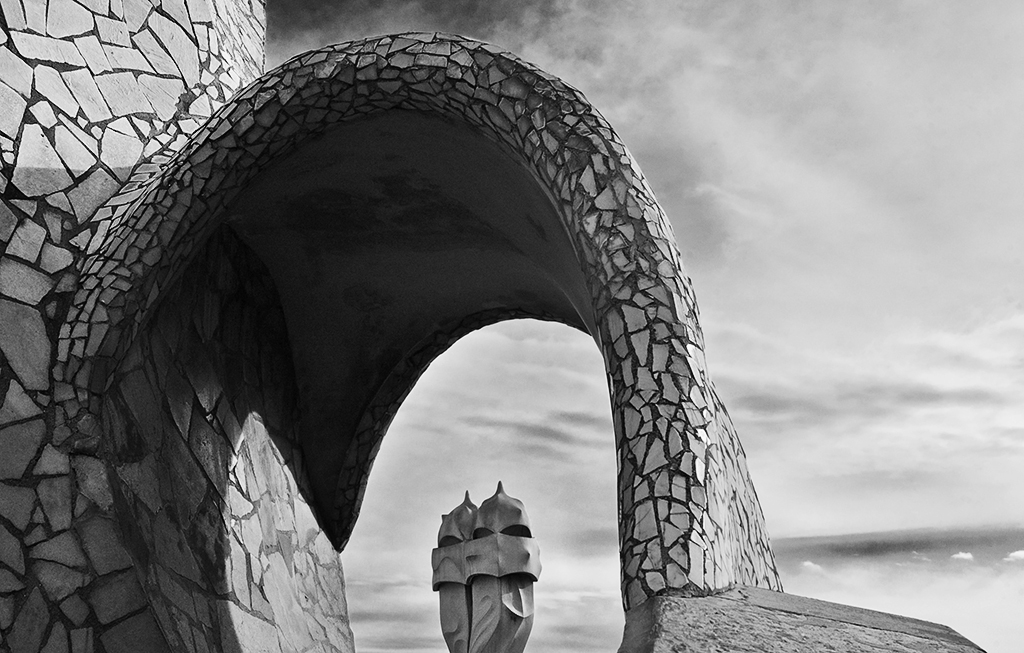
Antoni Gaudi, a genius of architecture and superlative artist dominated geometry like few others.
In modern times he would certainly be working in the video game industry as a designer creating 3D virtual worlds with due respect to the obvious differences of course.
This is the roof of renown Casa Mila, which is, together with Casa Batllo and Sagrada Familia, one of the best samples of Gaudinian creative and geometry aware imagination.
In black and white the lines are more evident as in some sort of charcoal sketch.
In modern times he would certainly be working in the video game industry as a designer creating 3D virtual worlds with due respect to the obvious differences of course.
This is the roof of renown Casa Mila, which is, together with Casa Batllo and Sagrada Familia, one of the best samples of Gaudinian creative and geometry aware imagination.
In black and white the lines are more evident as in some sort of charcoal sketch.
November 12, 2010
Antoni Tapies Foundation, Arago Street 255, Barcelona
Weird places well deserve weird, psychedelic approaches. I have walked past this building a thousand times and a thousand times I haven't been able to take a decent picture. First because you have to stand on the opposite sidewalk of carrer Aragó which is a very wide street, second because it is wedged in between two awful buildings and last but not least because those wires on top, which were conceived by Antoni Tàpies himself do break all the harmony of lines with the beautiful Art Nouveau façade by architect Lluís Domènech i Montaner. So I thought, what the heck, I've got to give this a colorful touch. The result expresses not awe as in awesome, but rather as in aw...ful. I realize I am committing sacrilege here by trying to judge the artwork on the roof and the awkward appearance of an artistic sanctuary as it is Fundació Tàpies. In fact it is a magnificent building constructed between 1880 and 1885, one of the earliest samples of Art Nouveau in this part of the city, that breaks up with traditional 19th century eclecticism, introducing elements like iron and exposed brick, the latter evidencing clear Muslim influences. The place held the Montaner i Simon publishing house up to 1981, the most important in its field for decades (120 years of history) that became Antoni Tapies Foundation in 1990, acquiring category of historical monument in 1997. But what to say about Antoni Tàpies i Puig (he will be 87 next December 13, 2010), the incommensurable Catalan painter, sculptor and lithographer besides the fact I don't like the Cloud and Chair, 1990 sculpture on top of the building, well you better find out reading his biography at the official site: Antoni Tàpies Biography (Fundació Antoni Tàpies)
October 11, 2010
Art Nouveau Treasures: Casa Mila aka La Pedrera, Barcelona, Spain

We had seen the façade, we had the balconies, the door, the roof but we forgot to show you Casa Mila (La Pedrera) from inside.
Come to think of it, there is more from this mind-blowing building by Gaudi to be portrayed in Barcelona Photoblog, I am sure!
It takes some trouble to show the shadows properly without blowing up the skies so I spent some time playing with the settings in my Nikon. Anyway I've seen much better versions of this photo on the web.
To learn more: La Pedrera and Casa Milá facts and history.
Come to think of it, there is more from this mind-blowing building by Gaudi to be portrayed in Barcelona Photoblog, I am sure!
It takes some trouble to show the shadows properly without blowing up the skies so I spent some time playing with the settings in my Nikon. Anyway I've seen much better versions of this photo on the web.
To learn more: La Pedrera and Casa Milá facts and history.
April 26, 2010
Modernist Building at Plaza del Sol, Gracia Quarter, Barcelona

At Plaça del Sol square in Gracia quarter, the most bohemian neighborhood in Barcelona, there's a modernist building that really stands out due to its wonderful preservation. I have seen it in hundreds of pictures but I wanted to show my own version.
These pastel colors are real so imagine what a feast it was for my eyes to be able to contemplate this beauty from a terrace table across the square in the company of friends and chatting over some beers.
Buildings like this you have a gazillion in the city and believe me my friend, you don't need the beer to get a sudden break of emotive architectural admiration cause the sober ones seem to have the same expression of awe before most of them.
Come join us, it is fun, cultural and educational! By the way, you can even sit on the very floor of the square to have a pleasant chat or enjoy the best local paella at L' Envalira (Catalan link) next door. Envalira (Link from monopolizing travel company Tripadvisor)
These pastel colors are real so imagine what a feast it was for my eyes to be able to contemplate this beauty from a terrace table across the square in the company of friends and chatting over some beers.
Buildings like this you have a gazillion in the city and believe me my friend, you don't need the beer to get a sudden break of emotive architectural admiration cause the sober ones seem to have the same expression of awe before most of them.
Come join us, it is fun, cultural and educational! By the way, you can even sit on the very floor of the square to have a pleasant chat or enjoy the best local paella at L' Envalira (Catalan link) next door. Envalira (Link from monopolizing travel company Tripadvisor)
March 26, 2010
Zoological Museum of Barcelona: Modernist Tower Detail
The Zoological Museum of Barcelona which is part of what is known as Museu de Ciencies Naturals is located in Parc de la Ciutadella. I won't give too much detail, as I just wanted to show the picture and invite you to visit this modernist building. This is a detail of the tower of Moorish reminiscence against the sky. In fact, this is part of the Natural Science Museum which is a group including the Geology Museum (1882) by Antoni Rovira i Trias inaugurated first, the Botanical Garden in Montjuic mountain and this Art Nouveau jewel by Lluís Domènech i Montaner conceived as a cafe for the 1888 World Exhibition, later abandoned and reconditioned as history museum till 1920 when it finally held the Zoological Museum. Usually, it is known as The Three Dragons Castle. By the way, in between the Geology and Zoology museums there is also the Hivernacle, a gorgeous greenhouse. Both museums exhibit some interesting collections donated by Francesc Martorell i Peña, archeologist and naturalist plus later additions. The Zoology Museum is above all a place to remember those times in which natural science was a passion in Catalonia, a historic building with a charm of its own and not a top notch interactive institution. Come to think of it, that's the good thing about these premises, rickety furniture, dusty shelves, musty smell, spiderwebs, last century trophies and fascinating animals looking at you mysteriously. Maybe I am exaggerating here but you get the idea.
February 23, 2010
Casa Ramon Oller, Gran Via de les Corts Catalanes 658, Barcelona
Modernista balconies are authentic Barcelona hallmarks. Catalan Art Nouveau is everywhere, in every detail and displayed in full splendor. Gran Via de les Corts Catalanes, one of our main arteries holds very good samples of this art such as this apartment building at number 658. The place you see here is a restoration made in 1900-1901. The original house dates back to 1871 and had been designed by Eduard Fontseré. The reform was carried out by architect Pau Salvat i Espasa (1872-1923) later on. Notice the magnificent ironwork especially on the tribune and the leaded glass panels.
January 24, 2010
Art Nouveau Flower Motif on Old Modernist Pharmacy Façade
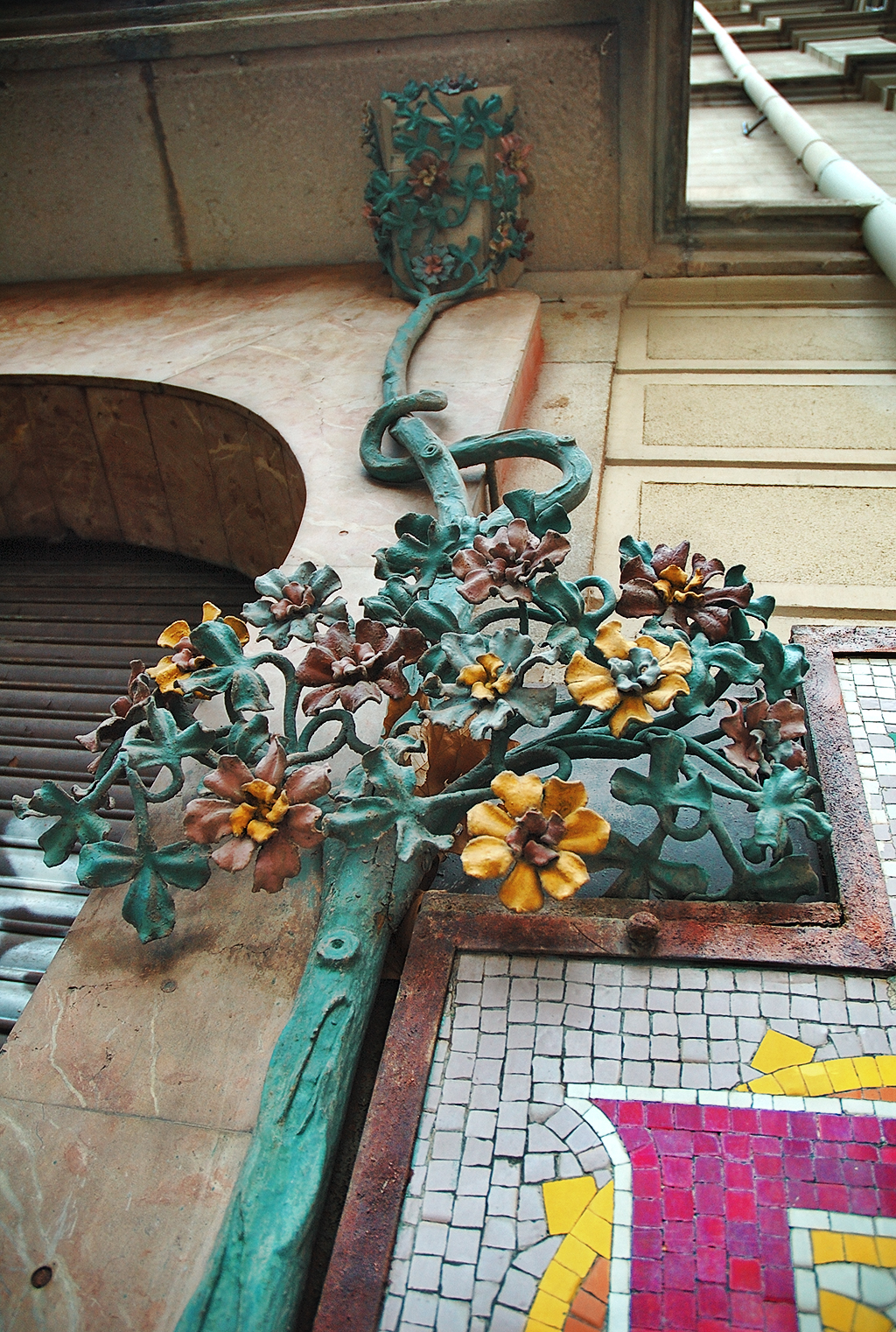
To welcome the new week I would like to share with you this beautiful flower motif found on the façade of the antique modernist Viladot pharmacy and laboratory once featured in this blog and located if I remember well, on the corner of carrer Bruc and Ronda de Sant Pere.
One of those small details scattered here and there in the city that you won't find unless you take a walk out of the usual touristic route.
Labels:
art nouveau,
modernisme,
pharmacy
Location: Barcelona, Spain
Carrer del Bruc, 8, 08010 Barcelona, Spain
September 17, 2009
Lamp Post by Falques, Avinguda Gaudi, Barcelona

There was a time when this modernist lamp post along with other three, were part of an imaginary geometric figure on a square at the intersection of Avinguda Diagonal and Passeig de Gracia known as Cinc D'Oros (Five of Gold in a deck of Spanish cards). Although the decision to make the square dates back to 1907, meant to honor Pi i Maragall, president of the Republic, it wasn't till 1915 that the place was fully conditioned.
First there were only the stones and a round space in the middle. The lamp posts, later fixed on the stones, were made in 1909 by architect Pere Falqués, the same artist that created the famous 31 lamps integrated on benches along Passeig de Gracia. Maybe it was by that time that the curious name after the five of gold card appeared cause they looked so from above.
In 1934 the monument was officially inaugurated with a sculpture by Viladomat in the middle. Such sculpture devoted to the Republic was later replaced by an obelisk and a lady representing Victory (1940), in this case of General Franco, by sculptor Frederic Marès.
The four lamp posts and the statue once unmounted were stored in a municipal warehouse at carrer Wellington. The sculpture dedicated to the Republic was placed at Llucmajor square in Nou Barris quarter in 1990 and the lamps, well, now you know where they are. All four of them can be admired along Avinguda Gaudi which goes from Sant Pau Hospital (at my back in the picture) to Sagrada Familia cathedral in the background. I hope you like the black and white option.
First there were only the stones and a round space in the middle. The lamp posts, later fixed on the stones, were made in 1909 by architect Pere Falqués, the same artist that created the famous 31 lamps integrated on benches along Passeig de Gracia. Maybe it was by that time that the curious name after the five of gold card appeared cause they looked so from above.
In 1934 the monument was officially inaugurated with a sculpture by Viladomat in the middle. Such sculpture devoted to the Republic was later replaced by an obelisk and a lady representing Victory (1940), in this case of General Franco, by sculptor Frederic Marès.
The four lamp posts and the statue once unmounted were stored in a municipal warehouse at carrer Wellington. The sculpture dedicated to the Republic was placed at Llucmajor square in Nou Barris quarter in 1990 and the lamps, well, now you know where they are. All four of them can be admired along Avinguda Gaudi which goes from Sant Pau Hospital (at my back in the picture) to Sagrada Familia cathedral in the background. I hope you like the black and white option.
July 20, 2009
Sant Pau Hospital: A Touch of Fresh Air in Architecture
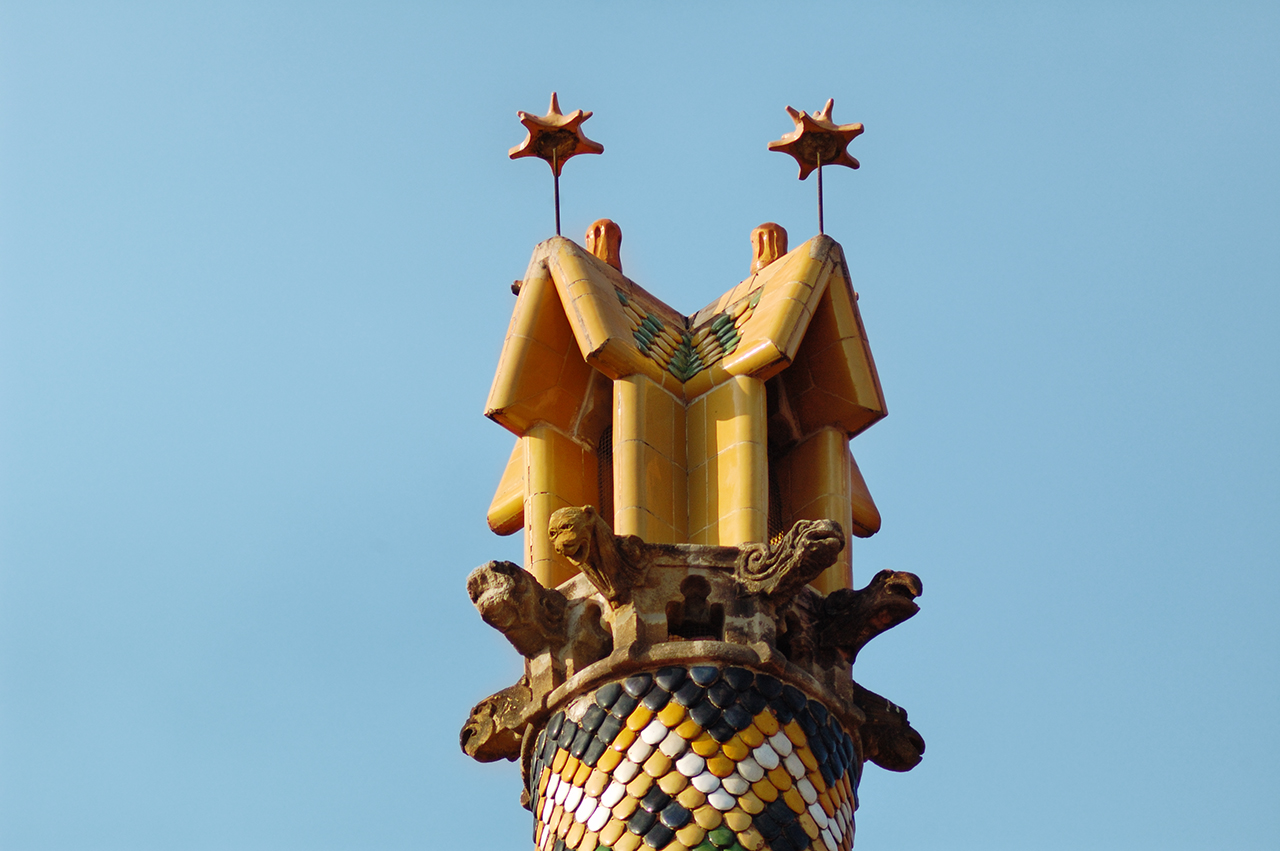
If you want to see a good sample of Catalan art nouveau take a walk inside Hospital de la Santa Creu i Sant Pau.
I have mentioned this jewel of modernist architecture before in many posts. I just want you to stop and take a look at the details.
There are some small ventilation towers or art nouveau chimney stacks that do deserve some of your time.
Adorned in a very similar way to nearby cupolas with overlapped fish scale-like tiles they carry some extra decoration that makes them stand out from the rest of motifs on the roof and part of the façade. Notice the use of tiny gargoyles to deviate water from the duct and bigger yellow tiles to embellish the box where the vents are. I particularly like those two stars which give it this sort of bizarre look.
These turrets were made just for ventilation purposes because the heating, water, gas and electricity services are installed in the open.
Domenech i Montaner, the architect behind these magnificent buildings, made emphasis on the human factor, on the well being of patients so fresh air, obtained thanks to this innovative system of natural ventilation, was a priority within the isolated, one-storey pavilions surrounded by gardens. In fact, pavilions are connected by underground corridors that were used to transport patients and for some medical services thus keeping the atmosphere on the surface much cleaner and less noisy.
I have mentioned this jewel of modernist architecture before in many posts. I just want you to stop and take a look at the details.
There are some small ventilation towers or art nouveau chimney stacks that do deserve some of your time.
Adorned in a very similar way to nearby cupolas with overlapped fish scale-like tiles they carry some extra decoration that makes them stand out from the rest of motifs on the roof and part of the façade. Notice the use of tiny gargoyles to deviate water from the duct and bigger yellow tiles to embellish the box where the vents are. I particularly like those two stars which give it this sort of bizarre look.
These turrets were made just for ventilation purposes because the heating, water, gas and electricity services are installed in the open.
Domenech i Montaner, the architect behind these magnificent buildings, made emphasis on the human factor, on the well being of patients so fresh air, obtained thanks to this innovative system of natural ventilation, was a priority within the isolated, one-storey pavilions surrounded by gardens. In fact, pavilions are connected by underground corridors that were used to transport patients and for some medical services thus keeping the atmosphere on the surface much cleaner and less noisy.
Location: Barcelona, Spain
Carrer de Sant Antoni Maria Claret, 167, 08025 Barcelona, Spain
February 09, 2009
Sant Pau Hospital: Cupolas

Can you imagine a hospital with buildings like this?
Think of a central square with colorful flowers and bloomed orange trees surrounded by brick wall pavilions crowned with beautiful Art Nouveau cupolas and literally covered with sculptures and assorted architectural adornments. That is not a dream, it exists. You only have to visit Sant Pau Hospital (Hospital de la Santa Creu i Sant Pau).
Maybe you would say: "No way, I don't like hospitals". Well, the pavilions are not functional anymore so they will not admit you as a patient. Just enter through the main gate on Cartagena street, one block away from L5 blue subway line. You can sit on a bench there, take a lot of wonderful pictures and most of all, enjoy the peaceful atmosphere of the place. When you leave you won't have the feeling you visited a hospital but the certainty that you have been in contact with a beautiful past.
Think of a central square with colorful flowers and bloomed orange trees surrounded by brick wall pavilions crowned with beautiful Art Nouveau cupolas and literally covered with sculptures and assorted architectural adornments. That is not a dream, it exists. You only have to visit Sant Pau Hospital (Hospital de la Santa Creu i Sant Pau).
Maybe you would say: "No way, I don't like hospitals". Well, the pavilions are not functional anymore so they will not admit you as a patient. Just enter through the main gate on Cartagena street, one block away from L5 blue subway line. You can sit on a bench there, take a lot of wonderful pictures and most of all, enjoy the peaceful atmosphere of the place. When you leave you won't have the feeling you visited a hospital but the certainty that you have been in contact with a beautiful past.
Labels:
architecture,
art nouveau,
cupola,
modernisme,
sant pau
Location: Barcelona, Spain
Carrer de Sant Antoni Maria Claret, 167, 08025 Barcelona, Spain
January 30, 2009
Modernist Lamp Ironwork: Imaginative Design

Near Sagrada Familia and all along Avinguda Gaudi you come across beautiful modernist lamps like the one in this picture. Well this is only a detail of the wonderful design of the ironwork. Check the modernist lamp at Gaudi Avenue on my Google Maps. Finding here in full view in this other post:
Lamp post by Falques, Avinguda Gaudi, Barcelona
Lamp post by Falques, Avinguda Gaudi, Barcelona
Look at this other beautiful street lamp near Arc de Triomf by Pere Falques.
Labels:
art nouveau,
ironwork,
lamp,
lamp post,
modernisme,
street lamp
Location: Barcelona, Spain
Av. de Gaudí, 08025 Barcelona, Spain
Subscribe to:
Posts (Atom)
Labels
architecture
(164)
modernisme
(81)
gaudi
(74)
art nouveau
(73)
food
(67)
flowers
(63)
street artist
(55)
sculpture
(48)
barri gotic
(39)
las ramblas
(39)
sagrada familia
(33)
dancers
(29)
beach
(28)
amusement park
(27)
port
(27)
human statue
(26)
art
(25)
mosaic
(25)
tibidabo
(25)
guell
(23)
barcelona streets
(22)
sant pau
(22)
tips
(22)
Catalan traditions
(21)
barcelona shop
(21)
market
(21)
montjuic
(21)
gothic quarter
(19)
la boqueria market
(18)
opinion
(18)
carnival
(17)
costa brava
(17)
domenech i montaner
(17)
christmas
(16)
ciutadella
(16)
maremagnum
(16)
folklore
(15)
classic
(14)
balcony
(13)
modernist
(13)
sea
(13)
street art
(13)
barcelona hotels
(12)
catalan art nouveau
(12)
catalan towns
(12)
costumes
(12)
graffiti
(12)
la pedrera
(12)
stained glass
(12)
casa mila
(11)
casa modernista
(11)
door
(11)
fountain
(11)
history
(11)
barcelona market
(10)
ceiling
(10)
la rambla
(10)
barcelona port
(9)
bikes
(9)
chocolate
(9)
crafts
(9)
paper mache
(9)
pedralbes
(9)
port aventura
(9)
vintage
(9)
architects
(8)
cosmocaixa
(8)
harbor
(8)
hotel
(8)
motorbike
(8)
passeig de gracia
(8)
arc de triomf
(7)
classic cars
(7)
dali
(7)
gracia
(4)
palau de la musica
(4)
accommodation
(3)
barcelona bar
(3)
casa batllo
(2)
cheese
(2)
cruises
(2)
gracia quarter
(2)
ham
(2)
wine
(2)
hostel
(1)
parc guell
(1)
picasso
(1)
